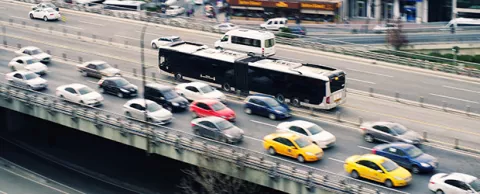
Traffic is a major drain on your economy. The typical London commuter wastes the equivalent of nearly three work weeks each year stuck in traffic. Workers in Los Angeles, Washington, D.C., and San Francisco don’t fare much better; they waste the equivalent of two weeks.
In addition to the lost productivity, all the emissions from the vehicles that are going nowhere contribute to climate change. And the problem gets worse every year.
Initiatives like a challenge grant from the U.S. Department of Transportation aim to find high-tech solutions. For our Special Theme Edition on smart transportation, however, we decided to start with cities that have some of the shortest commutes to see what we could learn from them. There are no quick fixes, but these cities do share some common attributes that you will want to consider for your own planning efforts. — Kevin Ebi
1. Don’t neglect the issue of distance
When developing strategies to ease congestion, it’s easy to fixate on the raw speed commuters travel. But that ignores another key part of the equation: how far commuters have to travel.
Milwaukee, Wisconsin, offers the third-shortest commutes of any major American city and a big reason why is that most people live close to their jobs. Three-quarters of those who work downtown live within 10 miles.
Granted, it’s not easy to get people to move back to the city, but be aware that if your downtown development plans displace more residents, you’re also putting more people on your already congested roads.
And Buffalo, New York, which has the best commute times in the U.S., has actually made progress in making its downtown more livable. The city replaced its old style single-use zoning codes in favor of place-based planning. The old code resulted in separate business and residential districts that practically required residents to drive everywhere; the new approach makes mixed-use development much easier.
2. Make it easy for bicyclists
Buses and trains aren’t the only things some commuters need. For some, bicycles need to be a key part of their commute, and to get them to use mass transit, your transit system needs to accommodate their bikes.
Cincinnati has the 10th-shortest commute times and nearly 20% of its downtown workers ride the bus. One reason why: it has equipped all of its buses with bike racks to accommodate those who want to ride to the bus stop.
London, which has the world’s worst commute times — the average commuter wastes 110 hours in traffic jams each year — is also concentrating on improving its bike systems. It’s working on cycle superhighways with dedicated lanes and signals. Before launching the effort, it found that some bicycle commutes could be absolutely excruciating, with some cyclists forced to take their bikes up and down flights of stairs to make connections.
3. Help people share rides
Obviously, it’s best to have a robust transit system, but it’s also important to give commuters options. Several cities that place in the top 10 help commuters share rides.
San Diego is one. Lyft Line has sprung up as the result of its entrepreneurial climate, allowing people to share rides with the private-vehicle taxi service with other commuters instead of riding solo.
Hartford, Connecticut, meanwhile, has made a concerted effort to promote carpool programs. It tied for the third-shortest commute.
Next steps: How to get smart about transportation
Each year, traffic congestion wastes more than $100 billion in lost productivity, and billions more in environmental damage and social costs. The Smart Cities Readiness Guide features tips and practical advice to put your smart transportation in high gear. See how Dublin uses connected sensors and analytics to keep its traffic moving and how Shanghai’s emphasis on traffic flow is giving it a competitive advantage.



